Tourism Consumer Behaviour and Decision Making Analysis
VerifiedAdded on 2023/01/11
|14
|4526
|72
Report
AI Summary
This report delves into the complexities of tourism consumer behavior, focusing on the factors that influence purchasing decisions and the impact of technology on consumer trends. It examines cultural, personal, social, and psychological influences, providing insights into how these elements shape consumer choices. The report analyzes the stages of the consumer decision-making journey, from need recognition to post-purchase evaluation, and maps a path to purchasing for tourism services. It also highlights the importance of understanding consumer behavior for marketers, especially in mapping the path to purchase and influencing consumer decisions. Furthermore, the report compares and contrasts the decision-making processes in business-to-business (B2B) and business-to-consumer (B2C) contexts within the hospitality sector and explores different market research approaches and methods. Finally, it discusses how marketers can influence the various stages of the tourism decision-making process to enhance customer engagement and satisfaction.
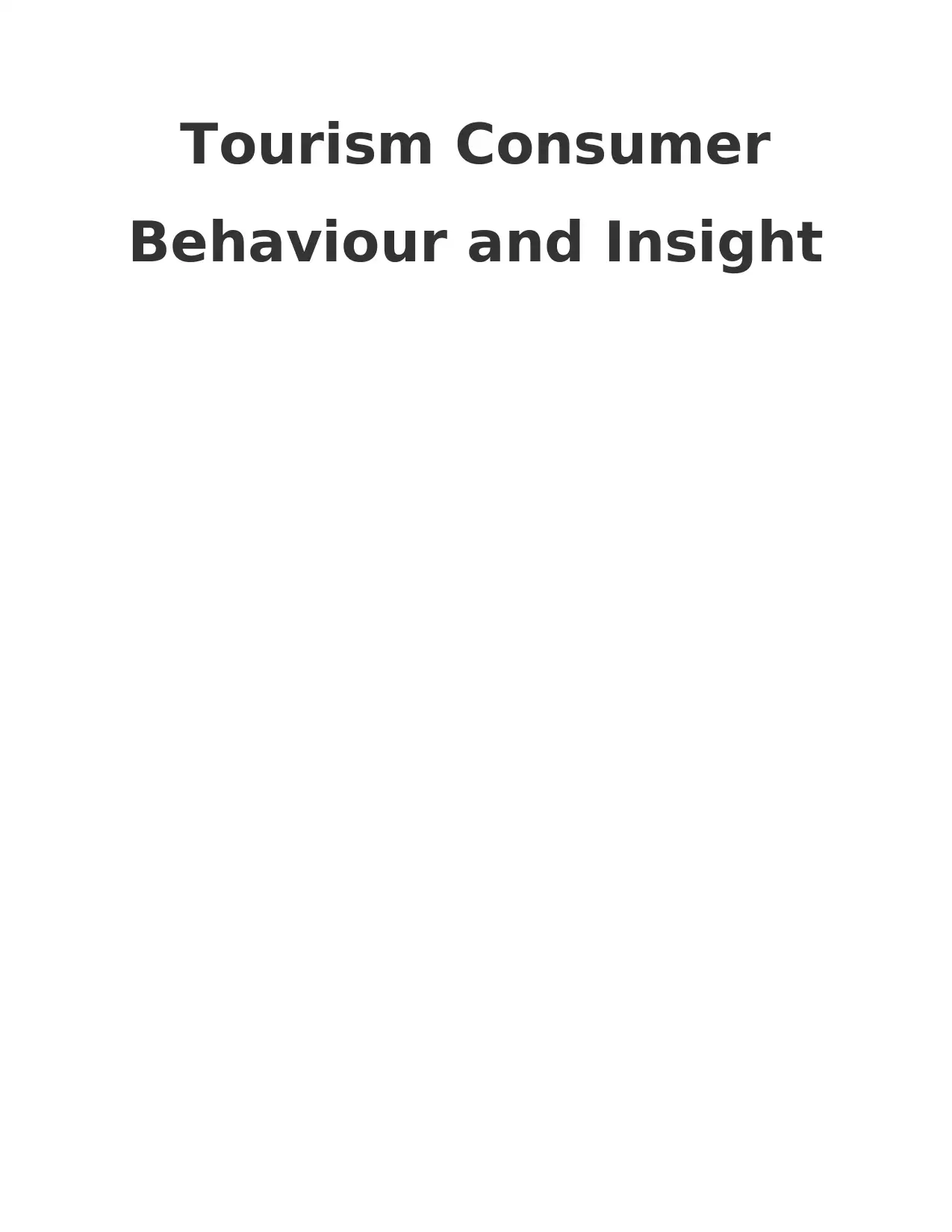
Tourism Consumer
Behaviour and Insight
Behaviour and Insight
Paraphrase This Document
Need a fresh take? Get an instant paraphrase of this document with our AI Paraphraser
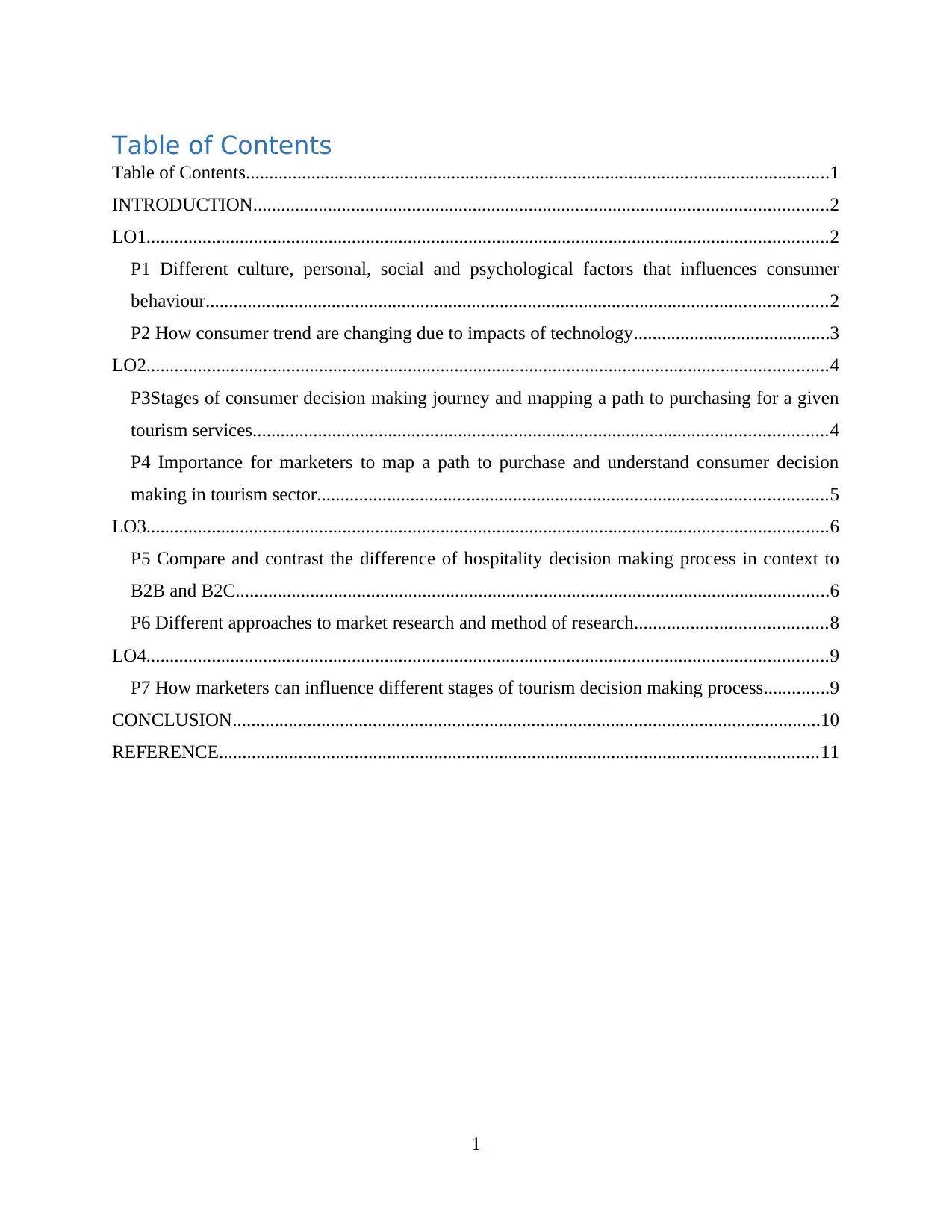
Table of Contents
Table of Contents.............................................................................................................................1
INTRODUCTION...........................................................................................................................2
LO1..................................................................................................................................................2
P1 Different culture, personal, social and psychological factors that influences consumer
behaviour.....................................................................................................................................2
P2 How consumer trend are changing due to impacts of technology..........................................3
LO2..................................................................................................................................................4
P3Stages of consumer decision making journey and mapping a path to purchasing for a given
tourism services...........................................................................................................................4
P4 Importance for marketers to map a path to purchase and understand consumer decision
making in tourism sector.............................................................................................................5
LO3..................................................................................................................................................6
P5 Compare and contrast the difference of hospitality decision making process in context to
B2B and B2C...............................................................................................................................6
P6 Different approaches to market research and method of research.........................................8
LO4..................................................................................................................................................9
P7 How marketers can influence different stages of tourism decision making process..............9
CONCLUSION..............................................................................................................................10
REFERENCE................................................................................................................................11
1
Table of Contents.............................................................................................................................1
INTRODUCTION...........................................................................................................................2
LO1..................................................................................................................................................2
P1 Different culture, personal, social and psychological factors that influences consumer
behaviour.....................................................................................................................................2
P2 How consumer trend are changing due to impacts of technology..........................................3
LO2..................................................................................................................................................4
P3Stages of consumer decision making journey and mapping a path to purchasing for a given
tourism services...........................................................................................................................4
P4 Importance for marketers to map a path to purchase and understand consumer decision
making in tourism sector.............................................................................................................5
LO3..................................................................................................................................................6
P5 Compare and contrast the difference of hospitality decision making process in context to
B2B and B2C...............................................................................................................................6
P6 Different approaches to market research and method of research.........................................8
LO4..................................................................................................................................................9
P7 How marketers can influence different stages of tourism decision making process..............9
CONCLUSION..............................................................................................................................10
REFERENCE................................................................................................................................11
1
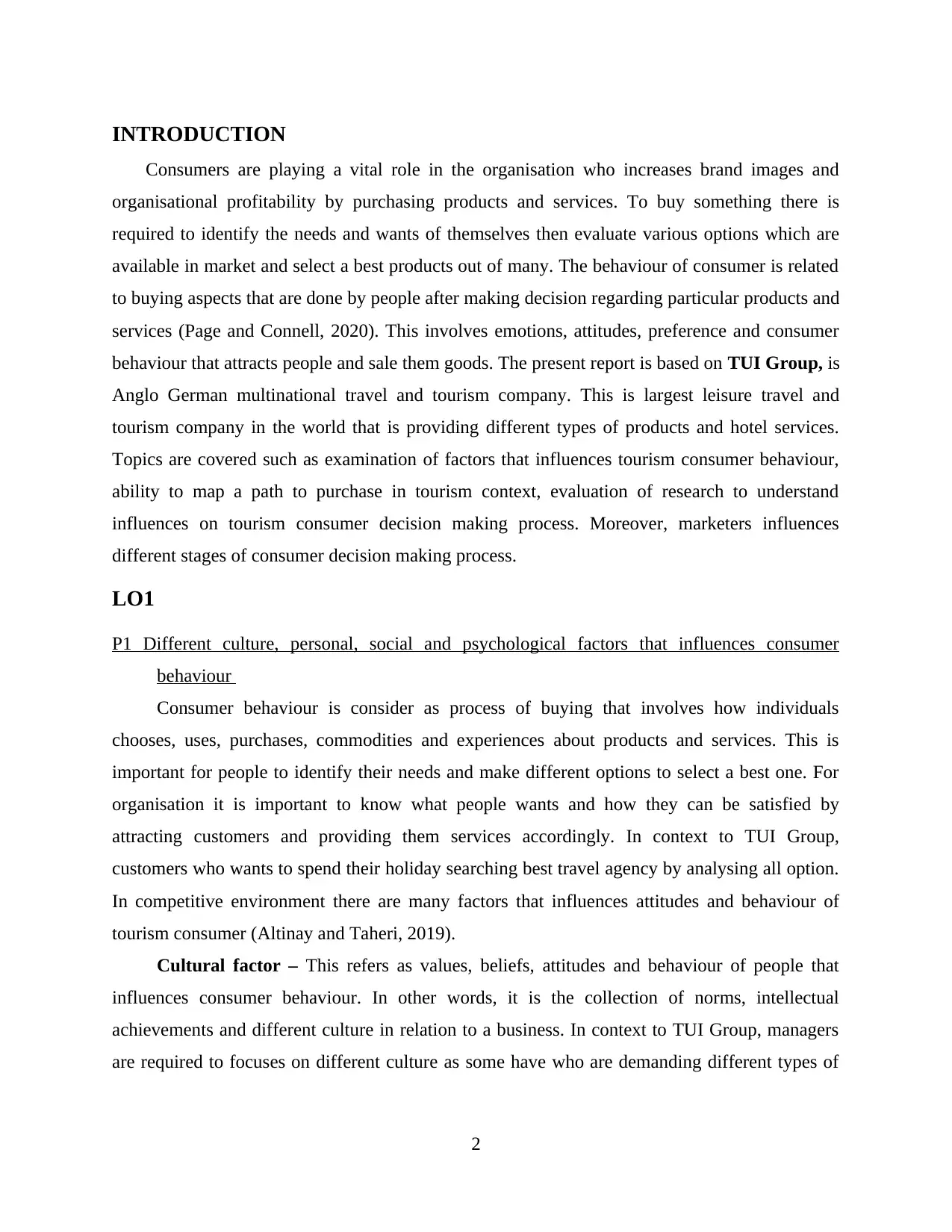
INTRODUCTION
Consumers are playing a vital role in the organisation who increases brand images and
organisational profitability by purchasing products and services. To buy something there is
required to identify the needs and wants of themselves then evaluate various options which are
available in market and select a best products out of many. The behaviour of consumer is related
to buying aspects that are done by people after making decision regarding particular products and
services (Page and Connell, 2020). This involves emotions, attitudes, preference and consumer
behaviour that attracts people and sale them goods. The present report is based on TUI Group, is
Anglo German multinational travel and tourism company. This is largest leisure travel and
tourism company in the world that is providing different types of products and hotel services.
Topics are covered such as examination of factors that influences tourism consumer behaviour,
ability to map a path to purchase in tourism context, evaluation of research to understand
influences on tourism consumer decision making process. Moreover, marketers influences
different stages of consumer decision making process.
LO1
P1 Different culture, personal, social and psychological factors that influences consumer
behaviour
Consumer behaviour is consider as process of buying that involves how individuals
chooses, uses, purchases, commodities and experiences about products and services. This is
important for people to identify their needs and make different options to select a best one. For
organisation it is important to know what people wants and how they can be satisfied by
attracting customers and providing them services accordingly. In context to TUI Group,
customers who wants to spend their holiday searching best travel agency by analysing all option.
In competitive environment there are many factors that influences attitudes and behaviour of
tourism consumer (Altinay and Taheri, 2019).
Cultural factor – This refers as values, beliefs, attitudes and behaviour of people that
influences consumer behaviour. In other words, it is the collection of norms, intellectual
achievements and different culture in relation to a business. In context to TUI Group, managers
are required to focuses on different culture as some have who are demanding different types of
2
Consumers are playing a vital role in the organisation who increases brand images and
organisational profitability by purchasing products and services. To buy something there is
required to identify the needs and wants of themselves then evaluate various options which are
available in market and select a best products out of many. The behaviour of consumer is related
to buying aspects that are done by people after making decision regarding particular products and
services (Page and Connell, 2020). This involves emotions, attitudes, preference and consumer
behaviour that attracts people and sale them goods. The present report is based on TUI Group, is
Anglo German multinational travel and tourism company. This is largest leisure travel and
tourism company in the world that is providing different types of products and hotel services.
Topics are covered such as examination of factors that influences tourism consumer behaviour,
ability to map a path to purchase in tourism context, evaluation of research to understand
influences on tourism consumer decision making process. Moreover, marketers influences
different stages of consumer decision making process.
LO1
P1 Different culture, personal, social and psychological factors that influences consumer
behaviour
Consumer behaviour is consider as process of buying that involves how individuals
chooses, uses, purchases, commodities and experiences about products and services. This is
important for people to identify their needs and make different options to select a best one. For
organisation it is important to know what people wants and how they can be satisfied by
attracting customers and providing them services accordingly. In context to TUI Group,
customers who wants to spend their holiday searching best travel agency by analysing all option.
In competitive environment there are many factors that influences attitudes and behaviour of
tourism consumer (Altinay and Taheri, 2019).
Cultural factor – This refers as values, beliefs, attitudes and behaviour of people that
influences consumer behaviour. In other words, it is the collection of norms, intellectual
achievements and different culture in relation to a business. In context to TUI Group, managers
are required to focuses on different culture as some have who are demanding different types of
2
⊘ This is a preview!⊘
Do you want full access?
Subscribe today to unlock all pages.

Trusted by 1+ million students worldwide
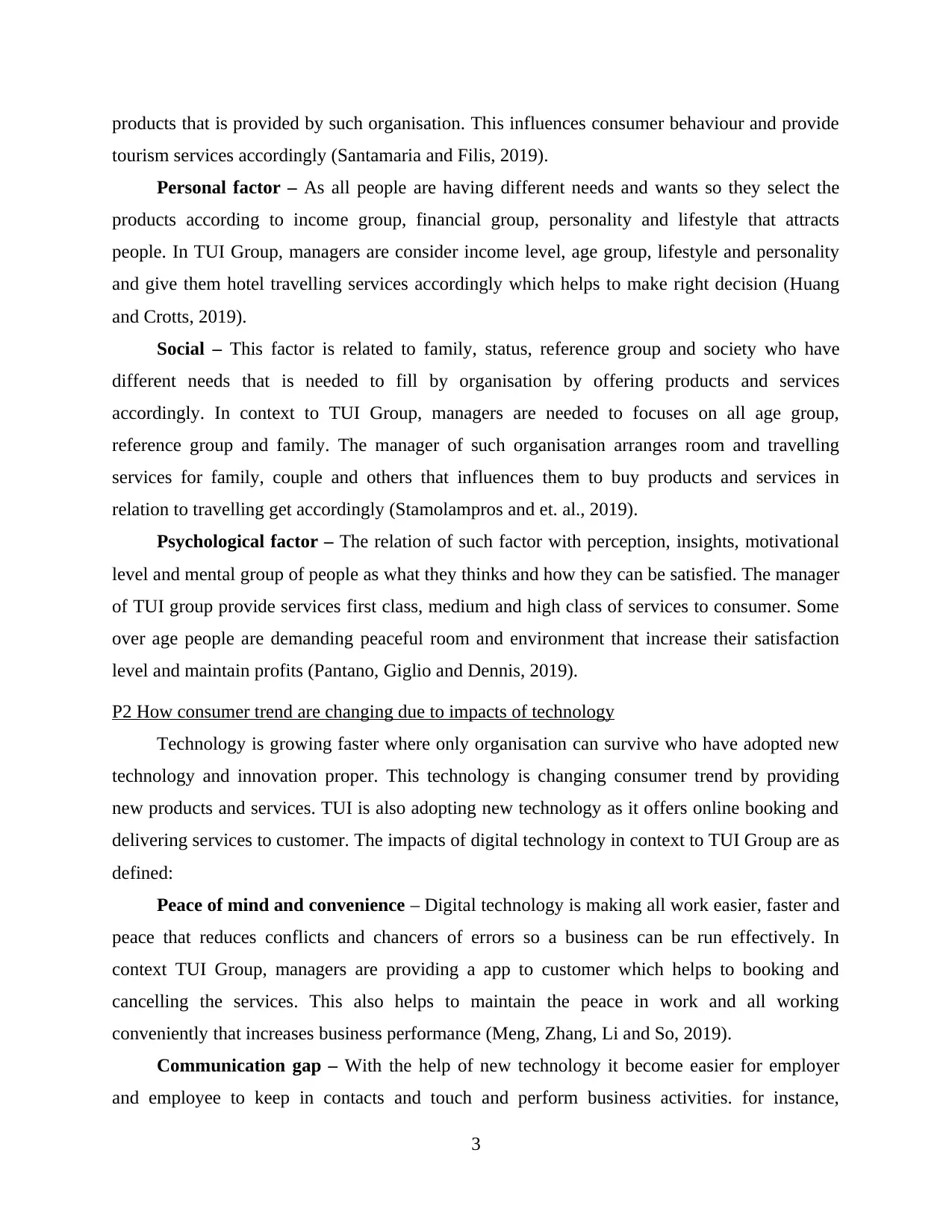
products that is provided by such organisation. This influences consumer behaviour and provide
tourism services accordingly (Santamaria and Filis, 2019).
Personal factor – As all people are having different needs and wants so they select the
products according to income group, financial group, personality and lifestyle that attracts
people. In TUI Group, managers are consider income level, age group, lifestyle and personality
and give them hotel travelling services accordingly which helps to make right decision (Huang
and Crotts, 2019).
Social – This factor is related to family, status, reference group and society who have
different needs that is needed to fill by organisation by offering products and services
accordingly. In context to TUI Group, managers are needed to focuses on all age group,
reference group and family. The manager of such organisation arranges room and travelling
services for family, couple and others that influences them to buy products and services in
relation to travelling get accordingly (Stamolampros and et. al., 2019).
Psychological factor – The relation of such factor with perception, insights, motivational
level and mental group of people as what they thinks and how they can be satisfied. The manager
of TUI group provide services first class, medium and high class of services to consumer. Some
over age people are demanding peaceful room and environment that increase their satisfaction
level and maintain profits (Pantano, Giglio and Dennis, 2019).
P2 How consumer trend are changing due to impacts of technology
Technology is growing faster where only organisation can survive who have adopted new
technology and innovation proper. This technology is changing consumer trend by providing
new products and services. TUI is also adopting new technology as it offers online booking and
delivering services to customer. The impacts of digital technology in context to TUI Group are as
defined:
Peace of mind and convenience – Digital technology is making all work easier, faster and
peace that reduces conflicts and chancers of errors so a business can be run effectively. In
context TUI Group, managers are providing a app to customer which helps to booking and
cancelling the services. This also helps to maintain the peace in work and all working
conveniently that increases business performance (Meng, Zhang, Li and So, 2019).
Communication gap – With the help of new technology it become easier for employer
and employee to keep in contacts and touch and perform business activities. for instance,
3
tourism services accordingly (Santamaria and Filis, 2019).
Personal factor – As all people are having different needs and wants so they select the
products according to income group, financial group, personality and lifestyle that attracts
people. In TUI Group, managers are consider income level, age group, lifestyle and personality
and give them hotel travelling services accordingly which helps to make right decision (Huang
and Crotts, 2019).
Social – This factor is related to family, status, reference group and society who have
different needs that is needed to fill by organisation by offering products and services
accordingly. In context to TUI Group, managers are needed to focuses on all age group,
reference group and family. The manager of such organisation arranges room and travelling
services for family, couple and others that influences them to buy products and services in
relation to travelling get accordingly (Stamolampros and et. al., 2019).
Psychological factor – The relation of such factor with perception, insights, motivational
level and mental group of people as what they thinks and how they can be satisfied. The manager
of TUI group provide services first class, medium and high class of services to consumer. Some
over age people are demanding peaceful room and environment that increase their satisfaction
level and maintain profits (Pantano, Giglio and Dennis, 2019).
P2 How consumer trend are changing due to impacts of technology
Technology is growing faster where only organisation can survive who have adopted new
technology and innovation proper. This technology is changing consumer trend by providing
new products and services. TUI is also adopting new technology as it offers online booking and
delivering services to customer. The impacts of digital technology in context to TUI Group are as
defined:
Peace of mind and convenience – Digital technology is making all work easier, faster and
peace that reduces conflicts and chancers of errors so a business can be run effectively. In
context TUI Group, managers are providing a app to customer which helps to booking and
cancelling the services. This also helps to maintain the peace in work and all working
conveniently that increases business performance (Meng, Zhang, Li and So, 2019).
Communication gap – With the help of new technology it become easier for employer
and employee to keep in contacts and touch and perform business activities. for instance,
3
Paraphrase This Document
Need a fresh take? Get an instant paraphrase of this document with our AI Paraphraser
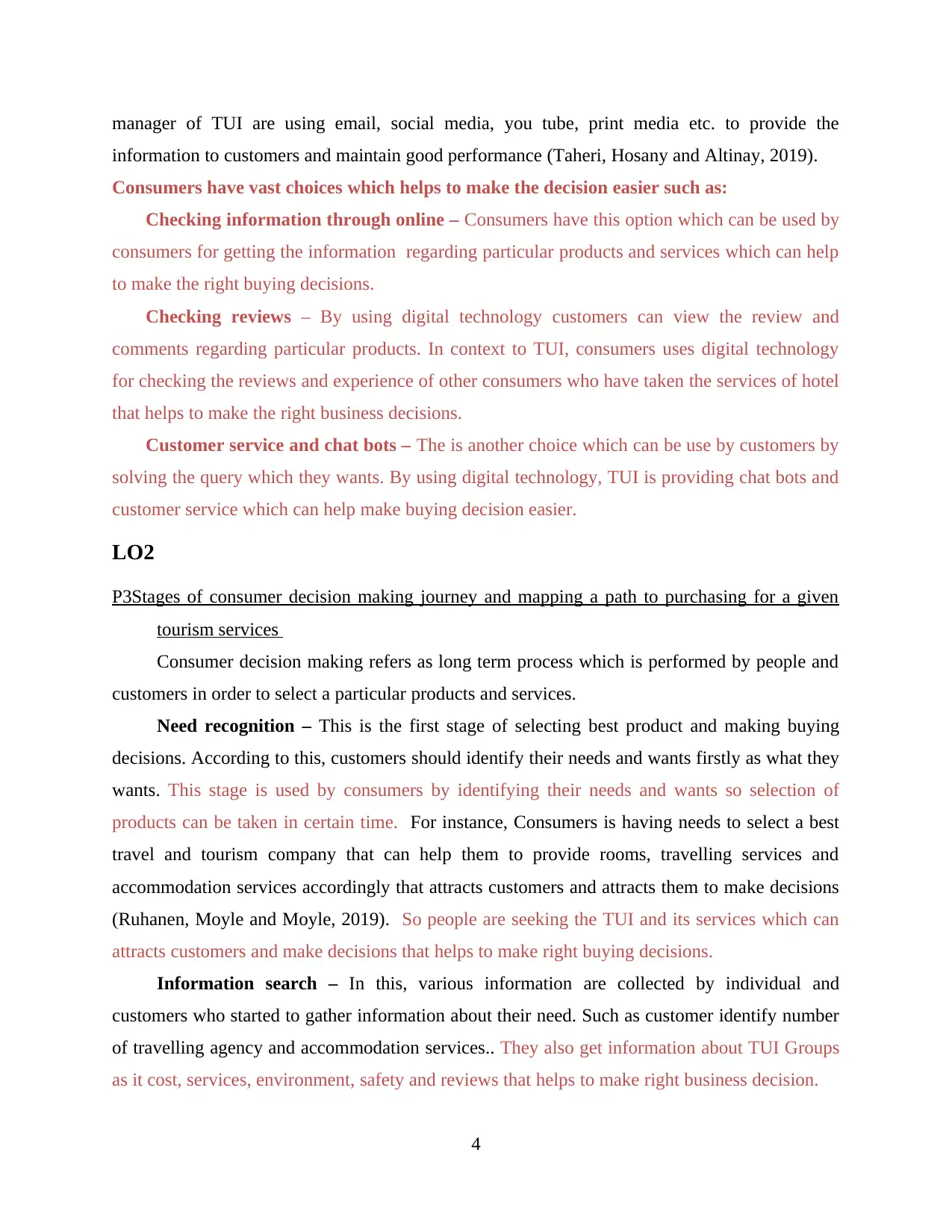
manager of TUI are using email, social media, you tube, print media etc. to provide the
information to customers and maintain good performance (Taheri, Hosany and Altinay, 2019).
Consumers have vast choices which helps to make the decision easier such as:
Checking information through online – Consumers have this option which can be used by
consumers for getting the information regarding particular products and services which can help
to make the right buying decisions.
Checking reviews – By using digital technology customers can view the review and
comments regarding particular products. In context to TUI, consumers uses digital technology
for checking the reviews and experience of other consumers who have taken the services of hotel
that helps to make the right business decisions.
Customer service and chat bots – The is another choice which can be use by customers by
solving the query which they wants. By using digital technology, TUI is providing chat bots and
customer service which can help make buying decision easier.
LO2
P3Stages of consumer decision making journey and mapping a path to purchasing for a given
tourism services
Consumer decision making refers as long term process which is performed by people and
customers in order to select a particular products and services.
Need recognition – This is the first stage of selecting best product and making buying
decisions. According to this, customers should identify their needs and wants firstly as what they
wants. This stage is used by consumers by identifying their needs and wants so selection of
products can be taken in certain time. For instance, Consumers is having needs to select a best
travel and tourism company that can help them to provide rooms, travelling services and
accommodation services accordingly that attracts customers and attracts them to make decisions
(Ruhanen, Moyle and Moyle, 2019). So people are seeking the TUI and its services which can
attracts customers and make decisions that helps to make right buying decisions.
Information search – In this, various information are collected by individual and
customers who started to gather information about their need. Such as customer identify number
of travelling agency and accommodation services.. They also get information about TUI Groups
as it cost, services, environment, safety and reviews that helps to make right business decision.
4
information to customers and maintain good performance (Taheri, Hosany and Altinay, 2019).
Consumers have vast choices which helps to make the decision easier such as:
Checking information through online – Consumers have this option which can be used by
consumers for getting the information regarding particular products and services which can help
to make the right buying decisions.
Checking reviews – By using digital technology customers can view the review and
comments regarding particular products. In context to TUI, consumers uses digital technology
for checking the reviews and experience of other consumers who have taken the services of hotel
that helps to make the right business decisions.
Customer service and chat bots – The is another choice which can be use by customers by
solving the query which they wants. By using digital technology, TUI is providing chat bots and
customer service which can help make buying decision easier.
LO2
P3Stages of consumer decision making journey and mapping a path to purchasing for a given
tourism services
Consumer decision making refers as long term process which is performed by people and
customers in order to select a particular products and services.
Need recognition – This is the first stage of selecting best product and making buying
decisions. According to this, customers should identify their needs and wants firstly as what they
wants. This stage is used by consumers by identifying their needs and wants so selection of
products can be taken in certain time. For instance, Consumers is having needs to select a best
travel and tourism company that can help them to provide rooms, travelling services and
accommodation services accordingly that attracts customers and attracts them to make decisions
(Ruhanen, Moyle and Moyle, 2019). So people are seeking the TUI and its services which can
attracts customers and make decisions that helps to make right buying decisions.
Information search – In this, various information are collected by individual and
customers who started to gather information about their need. Such as customer identify number
of travelling agency and accommodation services.. They also get information about TUI Groups
as it cost, services, environment, safety and reviews that helps to make right business decision.
4
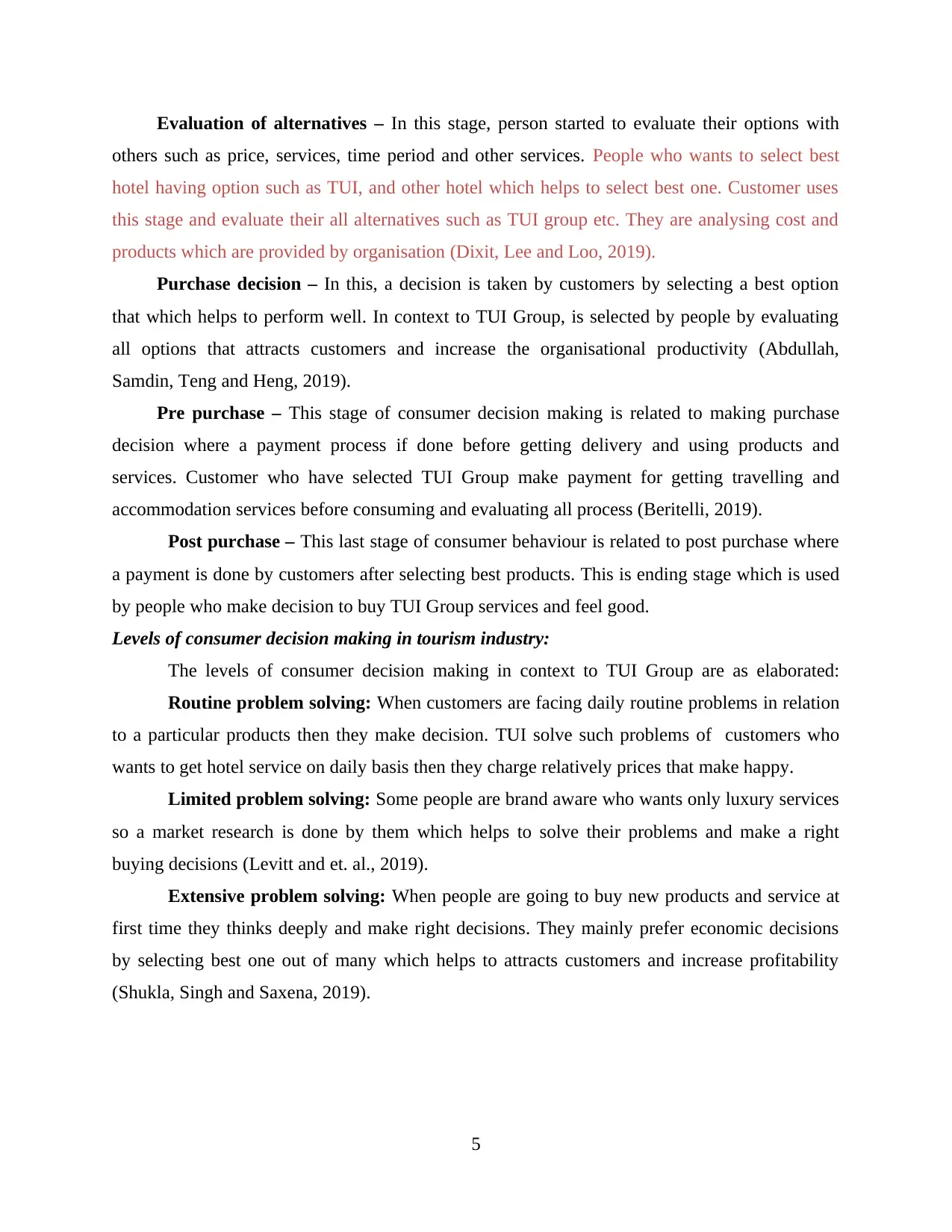
Evaluation of alternatives – In this stage, person started to evaluate their options with
others such as price, services, time period and other services. People who wants to select best
hotel having option such as TUI, and other hotel which helps to select best one. Customer uses
this stage and evaluate their all alternatives such as TUI group etc. They are analysing cost and
products which are provided by organisation (Dixit, Lee and Loo, 2019).
Purchase decision – In this, a decision is taken by customers by selecting a best option
that which helps to perform well. In context to TUI Group, is selected by people by evaluating
all options that attracts customers and increase the organisational productivity (Abdullah,
Samdin, Teng and Heng, 2019).
Pre purchase – This stage of consumer decision making is related to making purchase
decision where a payment process if done before getting delivery and using products and
services. Customer who have selected TUI Group make payment for getting travelling and
accommodation services before consuming and evaluating all process (Beritelli, 2019).
Post purchase – This last stage of consumer behaviour is related to post purchase where
a payment is done by customers after selecting best products. This is ending stage which is used
by people who make decision to buy TUI Group services and feel good.
Levels of consumer decision making in tourism industry:
The levels of consumer decision making in context to TUI Group are as elaborated:
Routine problem solving: When customers are facing daily routine problems in relation
to a particular products then they make decision. TUI solve such problems of customers who
wants to get hotel service on daily basis then they charge relatively prices that make happy.
Limited problem solving: Some people are brand aware who wants only luxury services
so a market research is done by them which helps to solve their problems and make a right
buying decisions (Levitt and et. al., 2019).
Extensive problem solving: When people are going to buy new products and service at
first time they thinks deeply and make right decisions. They mainly prefer economic decisions
by selecting best one out of many which helps to attracts customers and increase profitability
(Shukla, Singh and Saxena, 2019).
5
others such as price, services, time period and other services. People who wants to select best
hotel having option such as TUI, and other hotel which helps to select best one. Customer uses
this stage and evaluate their all alternatives such as TUI group etc. They are analysing cost and
products which are provided by organisation (Dixit, Lee and Loo, 2019).
Purchase decision – In this, a decision is taken by customers by selecting a best option
that which helps to perform well. In context to TUI Group, is selected by people by evaluating
all options that attracts customers and increase the organisational productivity (Abdullah,
Samdin, Teng and Heng, 2019).
Pre purchase – This stage of consumer decision making is related to making purchase
decision where a payment process if done before getting delivery and using products and
services. Customer who have selected TUI Group make payment for getting travelling and
accommodation services before consuming and evaluating all process (Beritelli, 2019).
Post purchase – This last stage of consumer behaviour is related to post purchase where
a payment is done by customers after selecting best products. This is ending stage which is used
by people who make decision to buy TUI Group services and feel good.
Levels of consumer decision making in tourism industry:
The levels of consumer decision making in context to TUI Group are as elaborated:
Routine problem solving: When customers are facing daily routine problems in relation
to a particular products then they make decision. TUI solve such problems of customers who
wants to get hotel service on daily basis then they charge relatively prices that make happy.
Limited problem solving: Some people are brand aware who wants only luxury services
so a market research is done by them which helps to solve their problems and make a right
buying decisions (Levitt and et. al., 2019).
Extensive problem solving: When people are going to buy new products and service at
first time they thinks deeply and make right decisions. They mainly prefer economic decisions
by selecting best one out of many which helps to attracts customers and increase profitability
(Shukla, Singh and Saxena, 2019).
5
⊘ This is a preview!⊘
Do you want full access?
Subscribe today to unlock all pages.

Trusted by 1+ million students worldwide
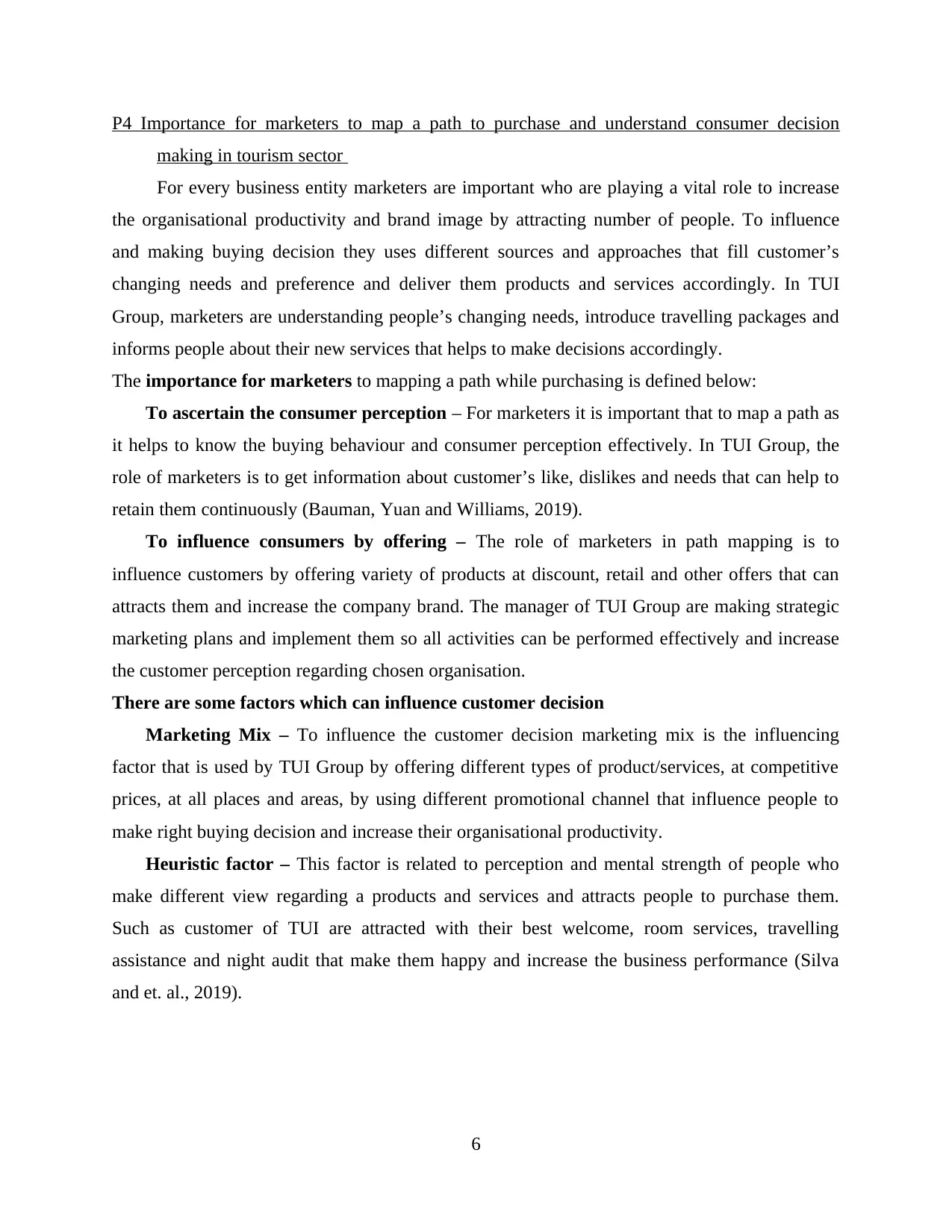
P4 Importance for marketers to map a path to purchase and understand consumer decision
making in tourism sector
For every business entity marketers are important who are playing a vital role to increase
the organisational productivity and brand image by attracting number of people. To influence
and making buying decision they uses different sources and approaches that fill customer’s
changing needs and preference and deliver them products and services accordingly. In TUI
Group, marketers are understanding people’s changing needs, introduce travelling packages and
informs people about their new services that helps to make decisions accordingly.
The importance for marketers to mapping a path while purchasing is defined below:
To ascertain the consumer perception – For marketers it is important that to map a path as
it helps to know the buying behaviour and consumer perception effectively. In TUI Group, the
role of marketers is to get information about customer’s like, dislikes and needs that can help to
retain them continuously (Bauman, Yuan and Williams, 2019).
To influence consumers by offering – The role of marketers in path mapping is to
influence customers by offering variety of products at discount, retail and other offers that can
attracts them and increase the company brand. The manager of TUI Group are making strategic
marketing plans and implement them so all activities can be performed effectively and increase
the customer perception regarding chosen organisation.
There are some factors which can influence customer decision
Marketing Mix – To influence the customer decision marketing mix is the influencing
factor that is used by TUI Group by offering different types of product/services, at competitive
prices, at all places and areas, by using different promotional channel that influence people to
make right buying decision and increase their organisational productivity.
Heuristic factor – This factor is related to perception and mental strength of people who
make different view regarding a products and services and attracts people to purchase them.
Such as customer of TUI are attracted with their best welcome, room services, travelling
assistance and night audit that make them happy and increase the business performance (Silva
and et. al., 2019).
6
making in tourism sector
For every business entity marketers are important who are playing a vital role to increase
the organisational productivity and brand image by attracting number of people. To influence
and making buying decision they uses different sources and approaches that fill customer’s
changing needs and preference and deliver them products and services accordingly. In TUI
Group, marketers are understanding people’s changing needs, introduce travelling packages and
informs people about their new services that helps to make decisions accordingly.
The importance for marketers to mapping a path while purchasing is defined below:
To ascertain the consumer perception – For marketers it is important that to map a path as
it helps to know the buying behaviour and consumer perception effectively. In TUI Group, the
role of marketers is to get information about customer’s like, dislikes and needs that can help to
retain them continuously (Bauman, Yuan and Williams, 2019).
To influence consumers by offering – The role of marketers in path mapping is to
influence customers by offering variety of products at discount, retail and other offers that can
attracts them and increase the company brand. The manager of TUI Group are making strategic
marketing plans and implement them so all activities can be performed effectively and increase
the customer perception regarding chosen organisation.
There are some factors which can influence customer decision
Marketing Mix – To influence the customer decision marketing mix is the influencing
factor that is used by TUI Group by offering different types of product/services, at competitive
prices, at all places and areas, by using different promotional channel that influence people to
make right buying decision and increase their organisational productivity.
Heuristic factor – This factor is related to perception and mental strength of people who
make different view regarding a products and services and attracts people to purchase them.
Such as customer of TUI are attracted with their best welcome, room services, travelling
assistance and night audit that make them happy and increase the business performance (Silva
and et. al., 2019).
6
Paraphrase This Document
Need a fresh take? Get an instant paraphrase of this document with our AI Paraphraser
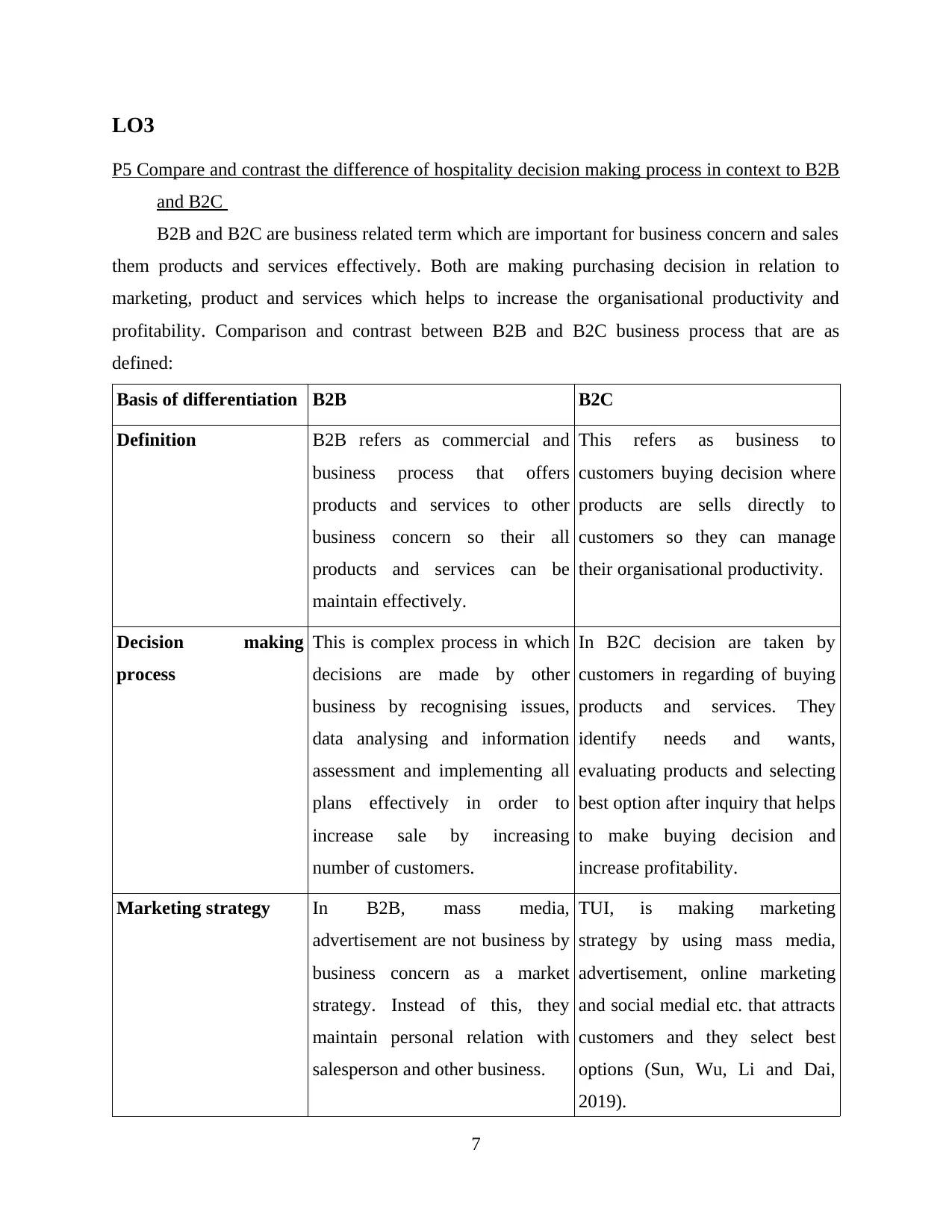
LO3
P5 Compare and contrast the difference of hospitality decision making process in context to B2B
and B2C
B2B and B2C are business related term which are important for business concern and sales
them products and services effectively. Both are making purchasing decision in relation to
marketing, product and services which helps to increase the organisational productivity and
profitability. Comparison and contrast between B2B and B2C business process that are as
defined:
Basis of differentiation B2B B2C
Definition B2B refers as commercial and
business process that offers
products and services to other
business concern so their all
products and services can be
maintain effectively.
This refers as business to
customers buying decision where
products are sells directly to
customers so they can manage
their organisational productivity.
Decision making
process
This is complex process in which
decisions are made by other
business by recognising issues,
data analysing and information
assessment and implementing all
plans effectively in order to
increase sale by increasing
number of customers.
In B2C decision are taken by
customers in regarding of buying
products and services. They
identify needs and wants,
evaluating products and selecting
best option after inquiry that helps
to make buying decision and
increase profitability.
Marketing strategy In B2B, mass media,
advertisement are not business by
business concern as a market
strategy. Instead of this, they
maintain personal relation with
salesperson and other business.
TUI, is making marketing
strategy by using mass media,
advertisement, online marketing
and social medial etc. that attracts
customers and they select best
options (Sun, Wu, Li and Dai,
2019).
7
P5 Compare and contrast the difference of hospitality decision making process in context to B2B
and B2C
B2B and B2C are business related term which are important for business concern and sales
them products and services effectively. Both are making purchasing decision in relation to
marketing, product and services which helps to increase the organisational productivity and
profitability. Comparison and contrast between B2B and B2C business process that are as
defined:
Basis of differentiation B2B B2C
Definition B2B refers as commercial and
business process that offers
products and services to other
business concern so their all
products and services can be
maintain effectively.
This refers as business to
customers buying decision where
products are sells directly to
customers so they can manage
their organisational productivity.
Decision making
process
This is complex process in which
decisions are made by other
business by recognising issues,
data analysing and information
assessment and implementing all
plans effectively in order to
increase sale by increasing
number of customers.
In B2C decision are taken by
customers in regarding of buying
products and services. They
identify needs and wants,
evaluating products and selecting
best option after inquiry that helps
to make buying decision and
increase profitability.
Marketing strategy In B2B, mass media,
advertisement are not business by
business concern as a market
strategy. Instead of this, they
maintain personal relation with
salesperson and other business.
TUI, is making marketing
strategy by using mass media,
advertisement, online marketing
and social medial etc. that attracts
customers and they select best
options (Sun, Wu, Li and Dai,
2019).
7
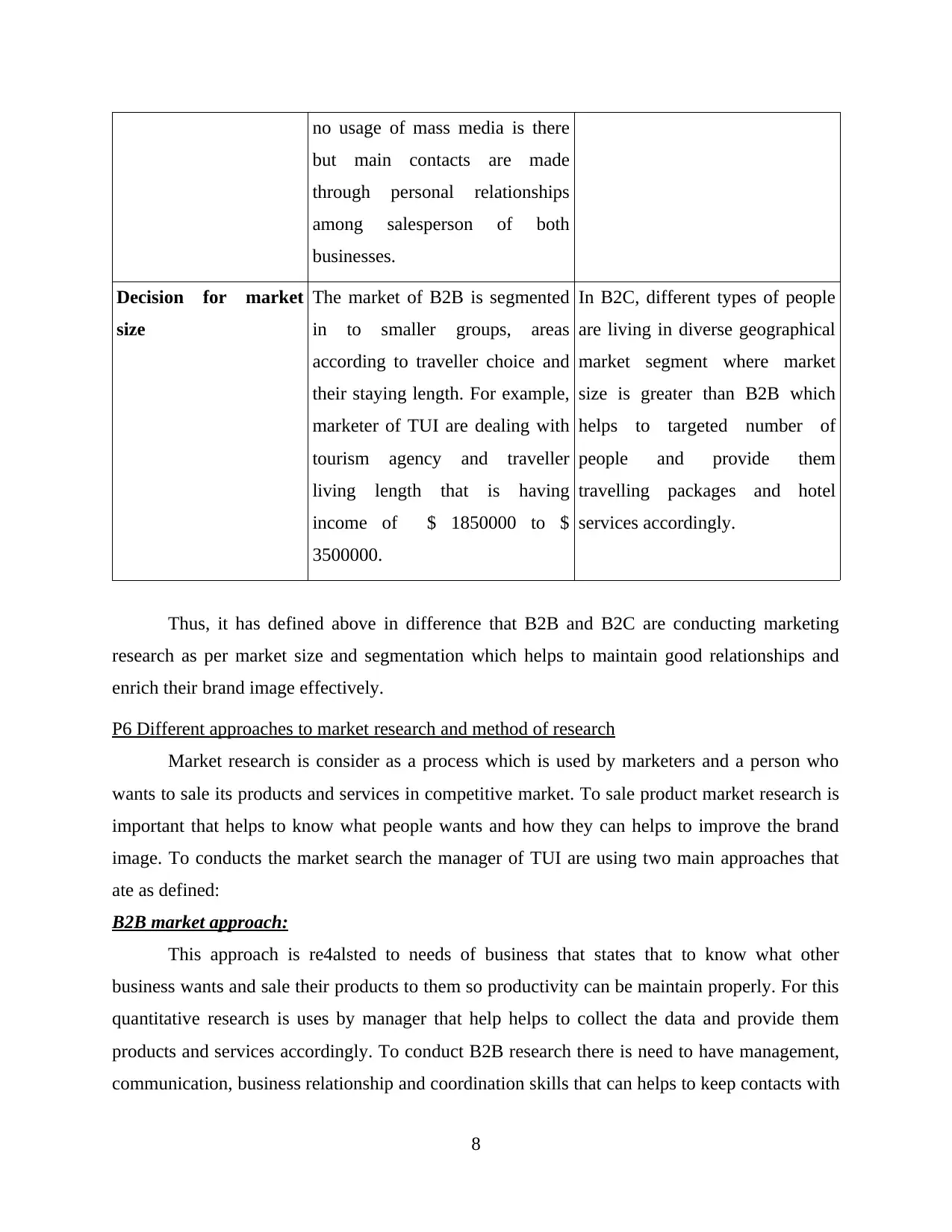
no usage of mass media is there
but main contacts are made
through personal relationships
among salesperson of both
businesses.
Decision for market
size
The market of B2B is segmented
in to smaller groups, areas
according to traveller choice and
their staying length. For example,
marketer of TUI are dealing with
tourism agency and traveller
living length that is having
income of $ 1850000 to $
3500000.
In B2C, different types of people
are living in diverse geographical
market segment where market
size is greater than B2B which
helps to targeted number of
people and provide them
travelling packages and hotel
services accordingly.
Thus, it has defined above in difference that B2B and B2C are conducting marketing
research as per market size and segmentation which helps to maintain good relationships and
enrich their brand image effectively.
P6 Different approaches to market research and method of research
Market research is consider as a process which is used by marketers and a person who
wants to sale its products and services in competitive market. To sale product market research is
important that helps to know what people wants and how they can helps to improve the brand
image. To conducts the market search the manager of TUI are using two main approaches that
ate as defined:
B2B market approach:
This approach is re4alsted to needs of business that states that to know what other
business wants and sale their products to them so productivity can be maintain properly. For this
quantitative research is uses by manager that help helps to collect the data and provide them
products and services accordingly. To conduct B2B research there is need to have management,
communication, business relationship and coordination skills that can helps to keep contacts with
8
but main contacts are made
through personal relationships
among salesperson of both
businesses.
Decision for market
size
The market of B2B is segmented
in to smaller groups, areas
according to traveller choice and
their staying length. For example,
marketer of TUI are dealing with
tourism agency and traveller
living length that is having
income of $ 1850000 to $
3500000.
In B2C, different types of people
are living in diverse geographical
market segment where market
size is greater than B2B which
helps to targeted number of
people and provide them
travelling packages and hotel
services accordingly.
Thus, it has defined above in difference that B2B and B2C are conducting marketing
research as per market size and segmentation which helps to maintain good relationships and
enrich their brand image effectively.
P6 Different approaches to market research and method of research
Market research is consider as a process which is used by marketers and a person who
wants to sale its products and services in competitive market. To sale product market research is
important that helps to know what people wants and how they can helps to improve the brand
image. To conducts the market search the manager of TUI are using two main approaches that
ate as defined:
B2B market approach:
This approach is re4alsted to needs of business that states that to know what other
business wants and sale their products to them so productivity can be maintain properly. For this
quantitative research is uses by manager that help helps to collect the data and provide them
products and services accordingly. To conduct B2B research there is need to have management,
communication, business relationship and coordination skills that can helps to keep contacts with
8
⊘ This is a preview!⊘
Do you want full access?
Subscribe today to unlock all pages.

Trusted by 1+ million students worldwide
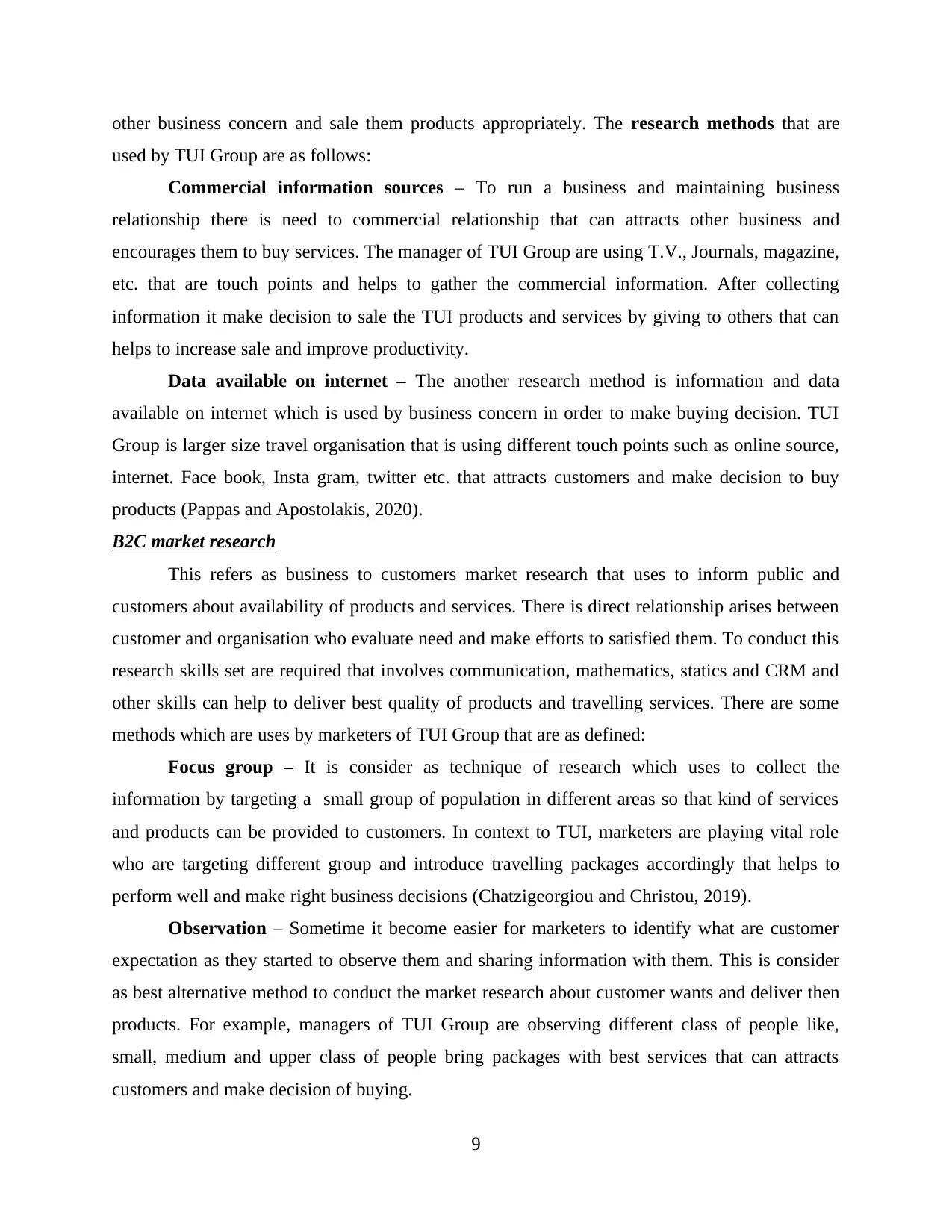
other business concern and sale them products appropriately. The research methods that are
used by TUI Group are as follows:
Commercial information sources – To run a business and maintaining business
relationship there is need to commercial relationship that can attracts other business and
encourages them to buy services. The manager of TUI Group are using T.V., Journals, magazine,
etc. that are touch points and helps to gather the commercial information. After collecting
information it make decision to sale the TUI products and services by giving to others that can
helps to increase sale and improve productivity.
Data available on internet – The another research method is information and data
available on internet which is used by business concern in order to make buying decision. TUI
Group is larger size travel organisation that is using different touch points such as online source,
internet. Face book, Insta gram, twitter etc. that attracts customers and make decision to buy
products (Pappas and Apostolakis, 2020).
B2C market research
This refers as business to customers market research that uses to inform public and
customers about availability of products and services. There is direct relationship arises between
customer and organisation who evaluate need and make efforts to satisfied them. To conduct this
research skills set are required that involves communication, mathematics, statics and CRM and
other skills can help to deliver best quality of products and travelling services. There are some
methods which are uses by marketers of TUI Group that are as defined:
Focus group – It is consider as technique of research which uses to collect the
information by targeting a small group of population in different areas so that kind of services
and products can be provided to customers. In context to TUI, marketers are playing vital role
who are targeting different group and introduce travelling packages accordingly that helps to
perform well and make right business decisions (Chatzigeorgiou and Christou, 2019).
Observation – Sometime it become easier for marketers to identify what are customer
expectation as they started to observe them and sharing information with them. This is consider
as best alternative method to conduct the market research about customer wants and deliver then
products. For example, managers of TUI Group are observing different class of people like,
small, medium and upper class of people bring packages with best services that can attracts
customers and make decision of buying.
9
used by TUI Group are as follows:
Commercial information sources – To run a business and maintaining business
relationship there is need to commercial relationship that can attracts other business and
encourages them to buy services. The manager of TUI Group are using T.V., Journals, magazine,
etc. that are touch points and helps to gather the commercial information. After collecting
information it make decision to sale the TUI products and services by giving to others that can
helps to increase sale and improve productivity.
Data available on internet – The another research method is information and data
available on internet which is used by business concern in order to make buying decision. TUI
Group is larger size travel organisation that is using different touch points such as online source,
internet. Face book, Insta gram, twitter etc. that attracts customers and make decision to buy
products (Pappas and Apostolakis, 2020).
B2C market research
This refers as business to customers market research that uses to inform public and
customers about availability of products and services. There is direct relationship arises between
customer and organisation who evaluate need and make efforts to satisfied them. To conduct this
research skills set are required that involves communication, mathematics, statics and CRM and
other skills can help to deliver best quality of products and travelling services. There are some
methods which are uses by marketers of TUI Group that are as defined:
Focus group – It is consider as technique of research which uses to collect the
information by targeting a small group of population in different areas so that kind of services
and products can be provided to customers. In context to TUI, marketers are playing vital role
who are targeting different group and introduce travelling packages accordingly that helps to
perform well and make right business decisions (Chatzigeorgiou and Christou, 2019).
Observation – Sometime it become easier for marketers to identify what are customer
expectation as they started to observe them and sharing information with them. This is consider
as best alternative method to conduct the market research about customer wants and deliver then
products. For example, managers of TUI Group are observing different class of people like,
small, medium and upper class of people bring packages with best services that can attracts
customers and make decision of buying.
9
Paraphrase This Document
Need a fresh take? Get an instant paraphrase of this document with our AI Paraphraser
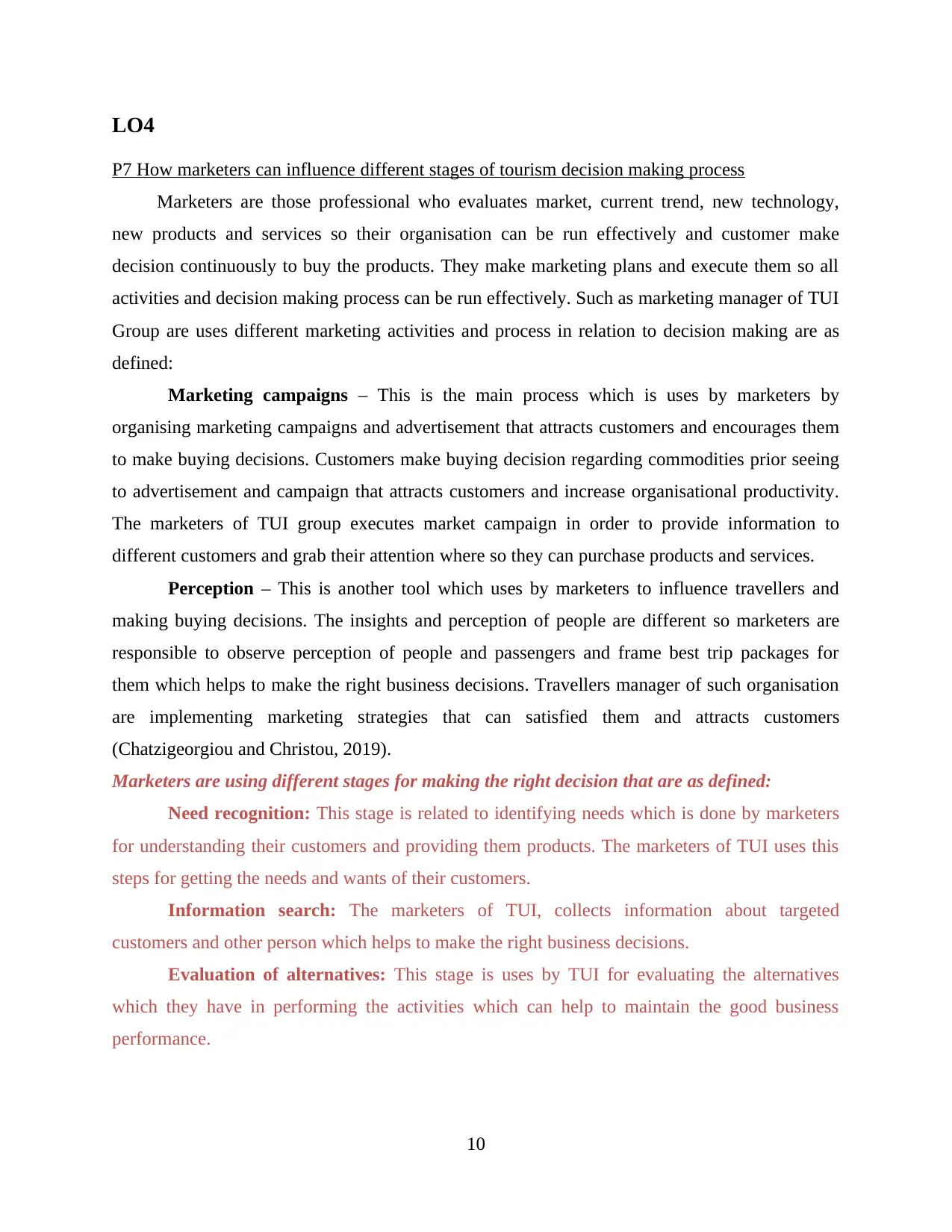
LO4
P7 How marketers can influence different stages of tourism decision making process
Marketers are those professional who evaluates market, current trend, new technology,
new products and services so their organisation can be run effectively and customer make
decision continuously to buy the products. They make marketing plans and execute them so all
activities and decision making process can be run effectively. Such as marketing manager of TUI
Group are uses different marketing activities and process in relation to decision making are as
defined:
Marketing campaigns – This is the main process which is uses by marketers by
organising marketing campaigns and advertisement that attracts customers and encourages them
to make buying decisions. Customers make buying decision regarding commodities prior seeing
to advertisement and campaign that attracts customers and increase organisational productivity.
The marketers of TUI group executes market campaign in order to provide information to
different customers and grab their attention where so they can purchase products and services.
Perception – This is another tool which uses by marketers to influence travellers and
making buying decisions. The insights and perception of people are different so marketers are
responsible to observe perception of people and passengers and frame best trip packages for
them which helps to make the right business decisions. Travellers manager of such organisation
are implementing marketing strategies that can satisfied them and attracts customers
(Chatzigeorgiou and Christou, 2019).
Marketers are using different stages for making the right decision that are as defined:
Need recognition: This stage is related to identifying needs which is done by marketers
for understanding their customers and providing them products. The marketers of TUI uses this
steps for getting the needs and wants of their customers.
Information search: The marketers of TUI, collects information about targeted
customers and other person which helps to make the right business decisions.
Evaluation of alternatives: This stage is uses by TUI for evaluating the alternatives
which they have in performing the activities which can help to maintain the good business
performance.
10
P7 How marketers can influence different stages of tourism decision making process
Marketers are those professional who evaluates market, current trend, new technology,
new products and services so their organisation can be run effectively and customer make
decision continuously to buy the products. They make marketing plans and execute them so all
activities and decision making process can be run effectively. Such as marketing manager of TUI
Group are uses different marketing activities and process in relation to decision making are as
defined:
Marketing campaigns – This is the main process which is uses by marketers by
organising marketing campaigns and advertisement that attracts customers and encourages them
to make buying decisions. Customers make buying decision regarding commodities prior seeing
to advertisement and campaign that attracts customers and increase organisational productivity.
The marketers of TUI group executes market campaign in order to provide information to
different customers and grab their attention where so they can purchase products and services.
Perception – This is another tool which uses by marketers to influence travellers and
making buying decisions. The insights and perception of people are different so marketers are
responsible to observe perception of people and passengers and frame best trip packages for
them which helps to make the right business decisions. Travellers manager of such organisation
are implementing marketing strategies that can satisfied them and attracts customers
(Chatzigeorgiou and Christou, 2019).
Marketers are using different stages for making the right decision that are as defined:
Need recognition: This stage is related to identifying needs which is done by marketers
for understanding their customers and providing them products. The marketers of TUI uses this
steps for getting the needs and wants of their customers.
Information search: The marketers of TUI, collects information about targeted
customers and other person which helps to make the right business decisions.
Evaluation of alternatives: This stage is uses by TUI for evaluating the alternatives
which they have in performing the activities which can help to maintain the good business
performance.
10
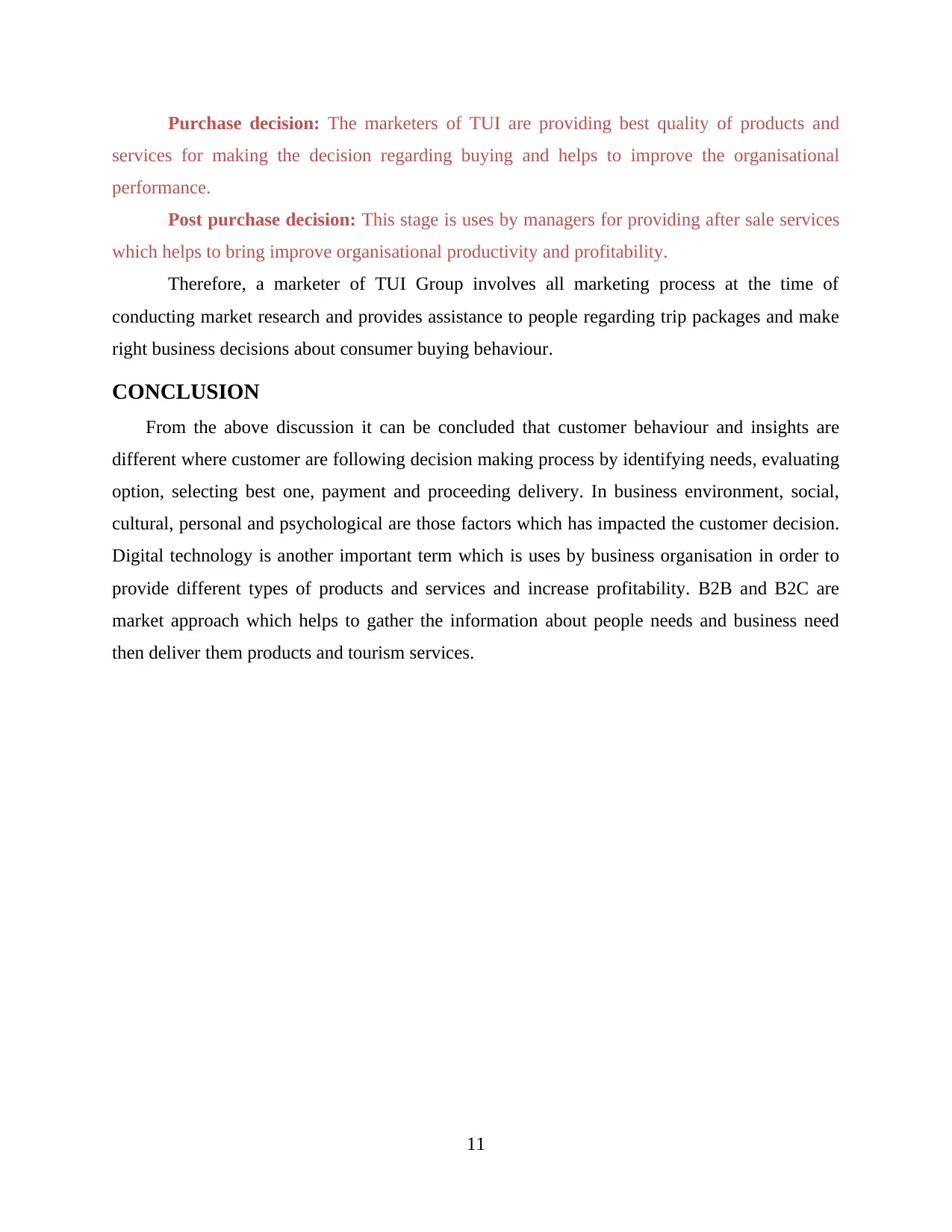
Purchase decision: The marketers of TUI are providing best quality of products and
services for making the decision regarding buying and helps to improve the organisational
performance.
Post purchase decision: This stage is uses by managers for providing after sale services
which helps to bring improve organisational productivity and profitability.
Therefore, a marketer of TUI Group involves all marketing process at the time of
conducting market research and provides assistance to people regarding trip packages and make
right business decisions about consumer buying behaviour.
CONCLUSION
From the above discussion it can be concluded that customer behaviour and insights are
different where customer are following decision making process by identifying needs, evaluating
option, selecting best one, payment and proceeding delivery. In business environment, social,
cultural, personal and psychological are those factors which has impacted the customer decision.
Digital technology is another important term which is uses by business organisation in order to
provide different types of products and services and increase profitability. B2B and B2C are
market approach which helps to gather the information about people needs and business need
then deliver them products and tourism services.
11
services for making the decision regarding buying and helps to improve the organisational
performance.
Post purchase decision: This stage is uses by managers for providing after sale services
which helps to bring improve organisational productivity and profitability.
Therefore, a marketer of TUI Group involves all marketing process at the time of
conducting market research and provides assistance to people regarding trip packages and make
right business decisions about consumer buying behaviour.
CONCLUSION
From the above discussion it can be concluded that customer behaviour and insights are
different where customer are following decision making process by identifying needs, evaluating
option, selecting best one, payment and proceeding delivery. In business environment, social,
cultural, personal and psychological are those factors which has impacted the customer decision.
Digital technology is another important term which is uses by business organisation in order to
provide different types of products and services and increase profitability. B2B and B2C are
market approach which helps to gather the information about people needs and business need
then deliver them products and tourism services.
11
⊘ This is a preview!⊘
Do you want full access?
Subscribe today to unlock all pages.

Trusted by 1+ million students worldwide
1 out of 14
Related Documents
Your All-in-One AI-Powered Toolkit for Academic Success.
+13062052269
info@desklib.com
Available 24*7 on WhatsApp / Email
![[object Object]](/_next/static/media/star-bottom.7253800d.svg)
Unlock your academic potential
Copyright © 2020–2025 A2Z Services. All Rights Reserved. Developed and managed by ZUCOL.




